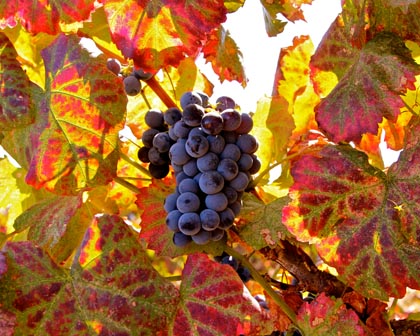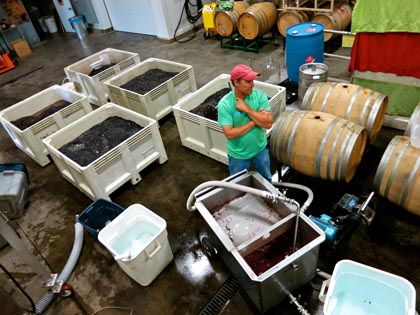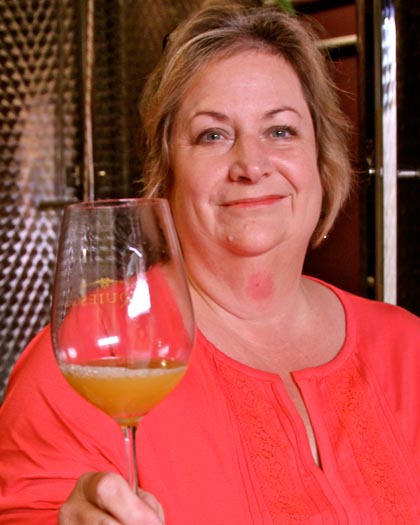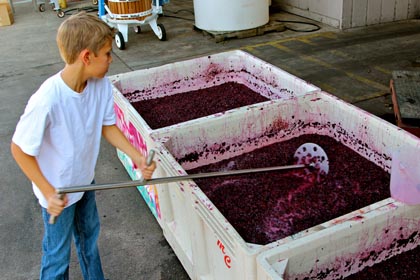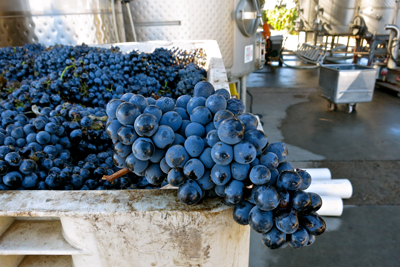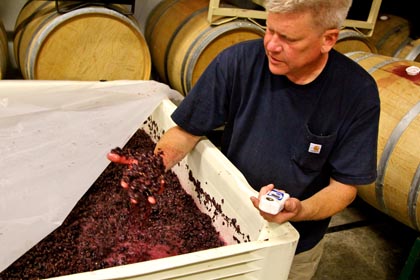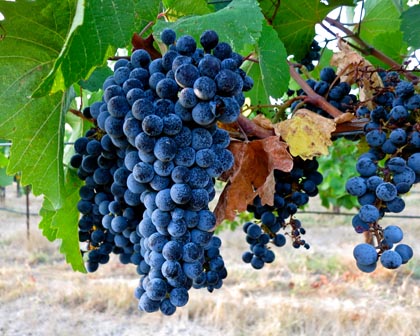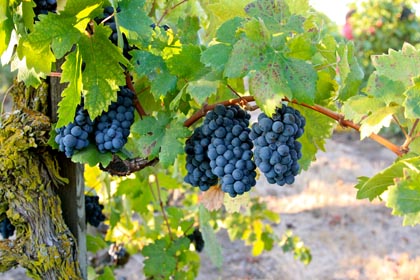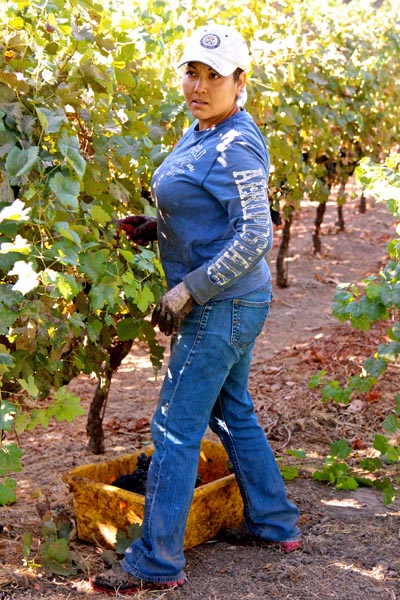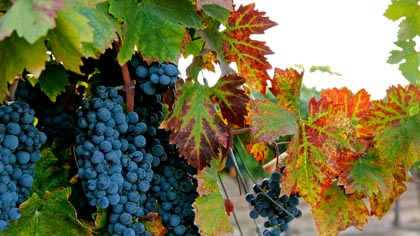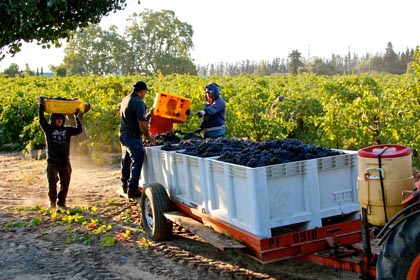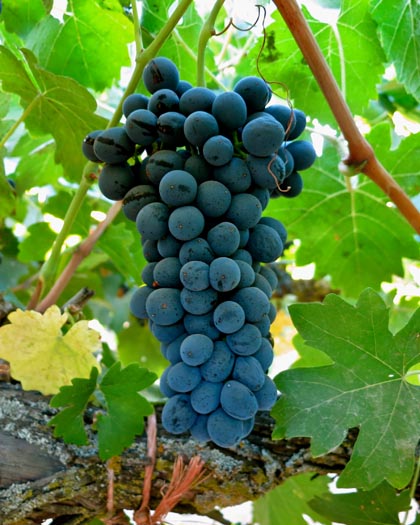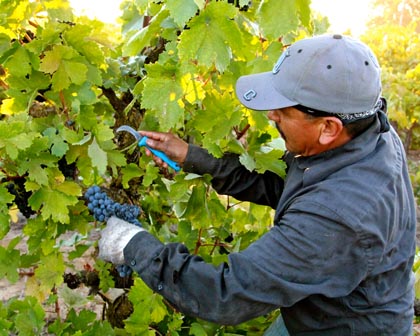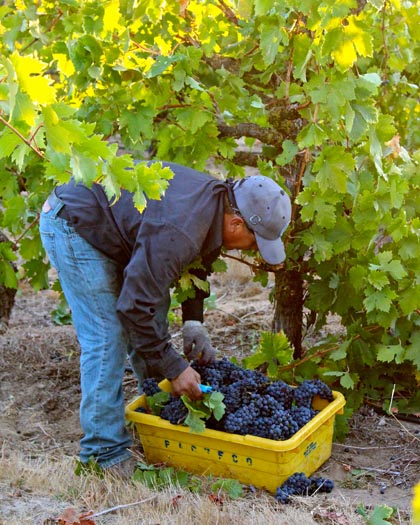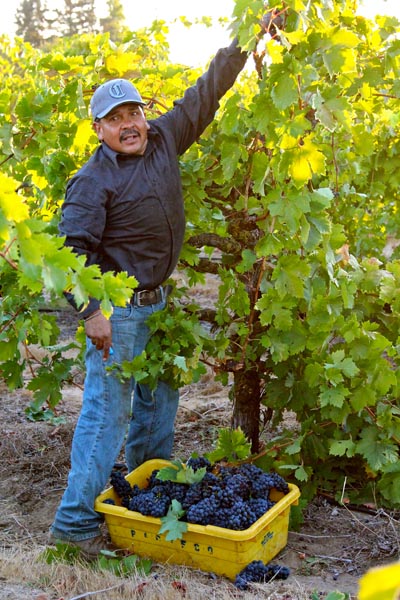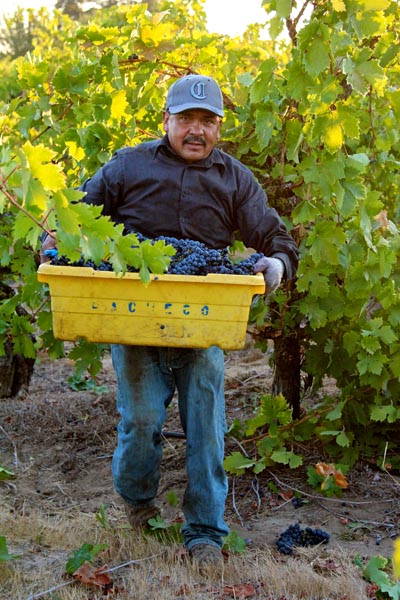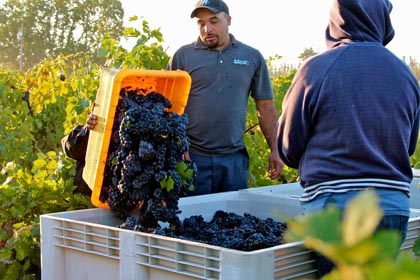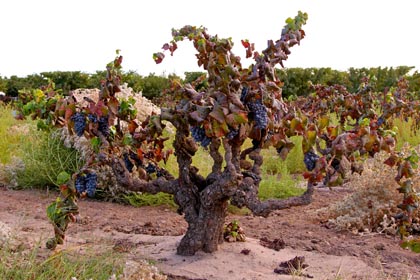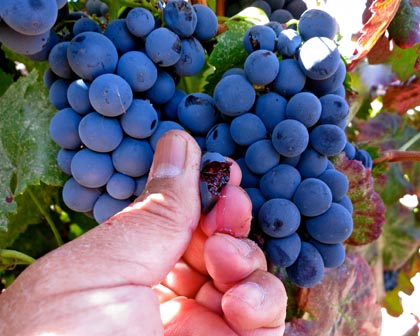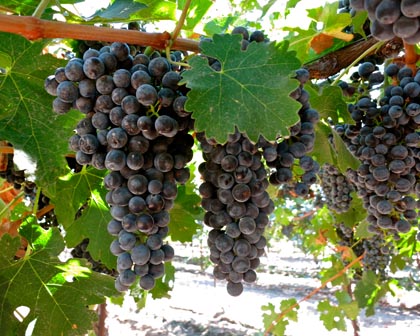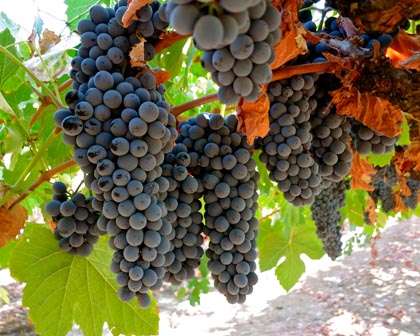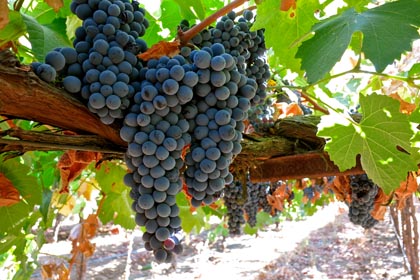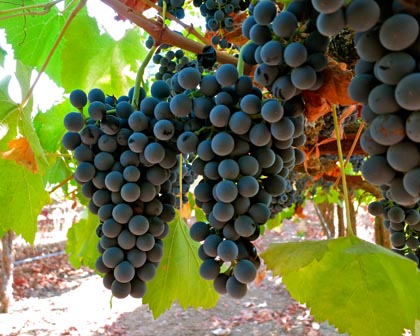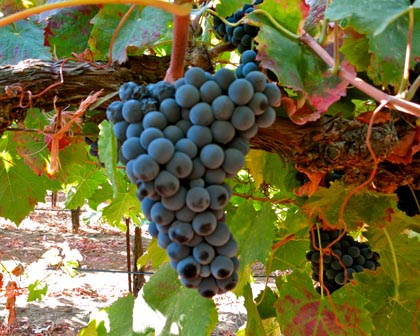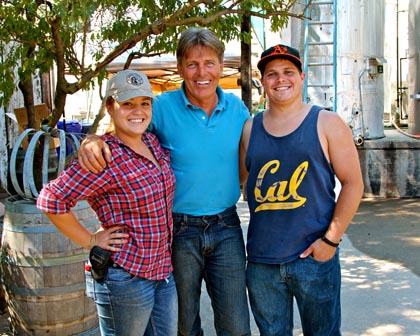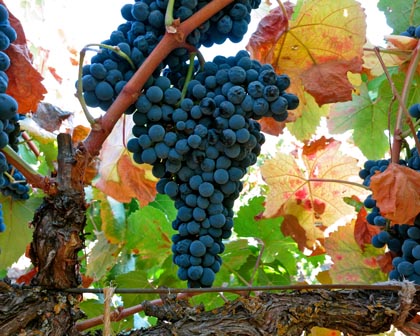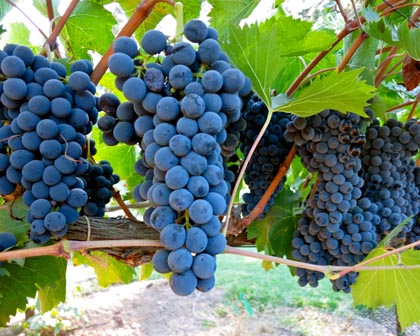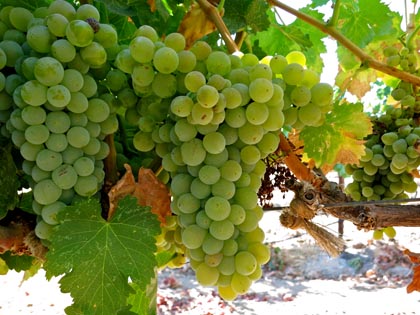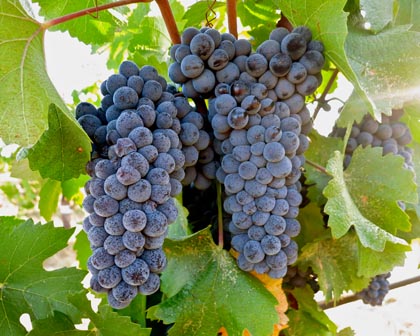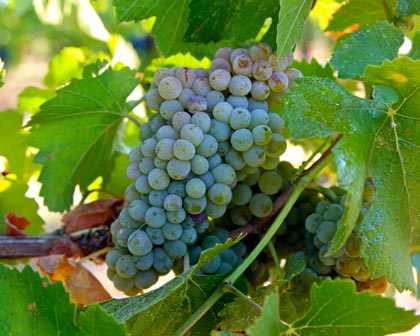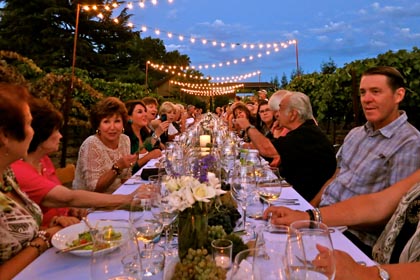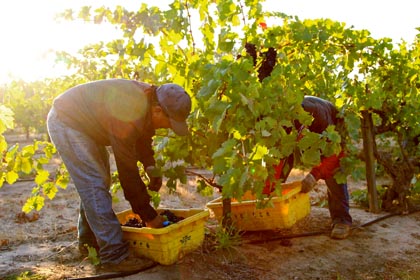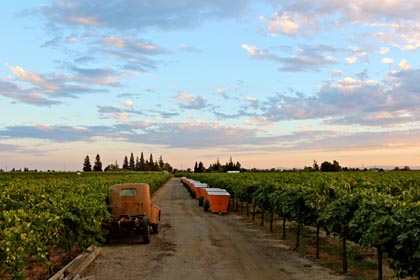Letters from Lodi
An insightful and objective look at viticulture and winemaking from the Lodi
Appellation and the growers and vintners behind these crafts. Told from the
perspective of multi-award winning wine journalist, Randy Caparoso.
Lodi’s Mediterranean identity reflected by huge diversity of grapes
Alicante Bouschet, September 2013: Lodi still cultivates blocks of this unusual wine grape, whose heyday was the first half of the last century
Harvest is a great time of year for photographing wine grapes, which become the most identifiable by their colors, shapes and overall morphology during that fleeting window just before they are picked.
Because Spring bud break and flowering occurred as much as two weeks ahead of normal in 2013, Lodi‘s harvest commenced during the first week of August with earlier ripening grapes like Sauvignon Blanc and Chardonnay, and higher acid/lower sugar Pinot Noir destined for sparkling wine production.
Traditionally, harvesting of black skinned grapes for the making of fuller bodied red wines doesn't start in earnest until mid-September, but this year it began during the last days of August. This went especially for the more highly regarded, older (those originally planted anywhere between 1888 and the 1960) Zinfandel plantings, which tend to produce lower yields. In every vintage, Lodi's lower yielding Zinfandel vineyards ripen faster than younger, more productive plantings. That's just the nature of old vines (like old "bulls," they focus sooner on what counts most, which is procreation of fruit) – but as always, smart winegrowers always expect the unexpected.
Harney Lane’s Kyle Lerner contemplates macro-bins of just-picked Lizzy James Vineyard (planted 1904) Zinfandel, harvested September 14
Be as it may, is it any wonder that the Lodi AVA (i.e. American Viticultural Area) does so well with so many cultivars of Vitis vinifera – that is, wine varieties belonging to the family of the "Common Grape Vine" that originated in the vicinity of the Mediterranean region, which connects Europe to southwestern Asia, Morocco and Portugal, as well as north towards southern Germany and easterly into northern Iran?
The reason is because of Lodi's Mediterranean climate. Sunset magazine, which is long been known for its precise renderings of the USDA's Plant Hardiness Zones, puts Lodi squarely in Zone 14 – “inland areas with some ocean influence.” Other areas in California that fall within Zone 14? Growing regions around Healdsburg in Sonoma County, St. Helena in Napa Valley, the hills of Paso Robles, and in the valleys of Santa Barbara County: not coincidentally, areas that are also well known for their wines produced from Vitis vinifera.
Acquiesce’s Sue Tipton with just-pressed Piquepoul Blanc (picked September 13)
Wait a minute, you might say, Lodi is not a coastal region – how can it be compared to Napa, Sonoma or Santa Barbara? Lodi may not be right on the coast, but it is smack dab in the mouth of the Sacramento-San Joaquin River Delta, which funnels moderating coastal air from San Francisco Bay through a narrow estuary called the Carquinez Strait – a patchwork of rivers, sloughs, canals, levees, marshland and floodplains hovering below or just above sea level. Think of it another way: Stockton, bordering the south end of the Lodi AVA, has always been a busy seaport (its nicknames include California's Sunrise Seaport, Mudville, and Port City); and in 1985, a full sized humpback whale (subsequently named Humphrey) famously made it all the way to Rio Vista, 25 miles west of Lodi.
You might not know it, judging from what is planted in most vineyards that are actually along the coast, but it is possible to grow a huge diversity of plants other than traditional European wine grapes in Zone 14. To quote Sunset: "Plants that grow naturally in each of these regions thrive in all dry-summer climates, so gardeners have a surprisingly large plant palette from which to choose. The familiar herbs ― lavender, rosemary, sage, santolina, and thyme ― are common choices for good reason: they provide sensual pleasure as well as beauty, and they’re tough as nails. California natives such as ceanothus, fremontodendron, and sagebrush, are other handsome choices. Also try blue hibiscus (Alyogyne huegelii), grevillea, kangaroo paw, and Westringia fruticosa from Australia; Cape mallow (Anisodontea x hypomandarum), Cape plumbago, kniphofia, leucospermum, and lion’s tail (Leonotis leonurus) from South Africa; or Pride of Madeira (Echium candicans) and rockrose from the Mediterranean region. All have developed strategies for surviving dry summers."
In this sense, Lodi is even more "Mediterranean" than other Zone 14 regions because it has always been so strongly agricultural; supplying the wine industry with a huge diversity of Vitis vinifera, from Alicante Bouschet to Zweigelt. Napa Valley, on the other hand, is an extreme example of a wine region constrained by its economics, its real estate, and even its success: you won't find blocks of Alicante Bouschet, Zweigelt, or other selections of wine grapes beyond the usual Cabernet Sauvignon, Merlot, Chardonnay, Sauvignon Blanc, etc. precisely because of the necessity of sticking to ultra-premium wine production. For places like Sonoma and Santa Barbara, it's the pressures wrought by the recent commercial success of Pinot Noir and the expense of developing vineyards to meet that demand, while staving off the realer possibility of seeing everything plowed under for more shopping malls or Neverlands for our 1%.
McCay Cellars’ Matt McCay punches down Bechthold Vineyard Cinsaut (picked August 30), nearing the end of its native yeast fermentation
Lodi, on the other hand, can take advantage of the diversity permitted by its Mediterranean climate because of its long history of providing lower cost fruit for, frankly, higher production wine. The important thing to remember is that Vitis vinifera has never been grown here in such large quantity (by far, the most in California) because it is a lousy place to grow grapes. It's grown here because it's a great place – the same way that it always has been for Napa and Sonoma (many people forget that up until just 30 years ago, E. & J. Gallo still took more than half the grapes grown in the North Coast for those same reasons). Even Lodi's former #1 table grape, Flame Tokay (no longer grown commercially because of its seeds), was a Vitis vinifera that never could attain consistent quality if grown north of Galt or south of Stockton – simply because it demanded an even narrower range of Mediterranean conditions (not too hot, not too cold), such as Lodi's.
It also helps that much of Lodi's real estate is still dominated by families who have been farming or ranching here as far back as the 1850s. They might not get half of what the gentleman farmers in Napa and Sonoma get for their Cabernet Sauvignon or Pinot Noir, but neither are they hampered by nearly the costs that exert the pressure to grow those few popular grapes in near exclusivity.
Heritage grape: Borra Vineyards Barbera, picked September, ready to go into co-ferment with Alicante Bouschet and Petite Sirah
And that's the beauty of Lodi, especially in the hands of a growing number of artisanal wine producers: we are now able to enjoy impeccably crafted wines from grapes like Albariño from Spain or Verdelho from Portugal, practically as everyday domestic wines. Where else can you source exquisite wines from less familiar grapes like Kerner (a white wine cross developed in Germany), Vermentino (as “Mediterranean” a white wine grape as they come), or Cinsaut from 127-year old vines (Lodi's Bechthold Vineyard)? Because of its established history, Lodi also remains a mother lode for winemakers interested in taking heritage grapes like Carignan, Grenache, Barbera, and Alicante Bouschet to another level.
Growers around the world cultivate thousands of Vitis vinifera selections for the purpose of producing wine (not to mention table grapes and raisins). We've counted over 100 wine grapes planted in Lodi – undoubtedly more than any one single region in the U.S. It's good to be able to say that it's "because we can," and neither climate nor economics are going to stop us.
m2′s Layne Montgomery takes measure of just-crushed Soucie Vineyard Zinfandel (picked September 13)
We know that the oldest use of wine grapes dates back to Neolithic times through the discovery of 7,000 year-old wine storage jars in present-day northern Iran. When you think of that, the Lodi wine grape industry is virtually a newborn: as with the rest of California (aside from missions along El Camino Real), we started at the same time that the 49ers – many of them of wine drinking European descent – came pouring down from the Foothills to establish farms and businesses, and later a town called Lodi (in the 1850s the settlement was originally called Mokelumne, and it is thought the name was changed shortly thereafter because some of the early settlers hailed from Lodi, Illinois).
That said, here are more delectable photographs depicting the September 2013 harvest and the rich diversity of wine grapes, both familiar and unfamiliar, planted in our Delta region:
Zweigelt (in Lodi’s Mokelumne Glen) is a successful Austrian crossing (St. Laurent x Blaufrankisch) yet to catch on in the U.S.
Amazing grace: Zinfandel, about to be picked in Lizzy James Vineyard
Borra Vineyards picker, harvesting estate Barbera
Primitivo (in Harney Lane estate) is a longer, looser clonal variant of Zinfandel
Harney Lane’s Lizzy James Vineyard Zinfandel harvest
Cabernet Franc in Watts Vineyard on Armstrong Rd. (picked by Phillips Farms in mid-September)
Harney Lane crew picking 109-year old Zinfandel vines in Lizzy James Vineyard (September 14)
Harney Lane crew picking 109-year old Zinfandel vines in Lizzy James Vineyard (September 14)
Harney Lane crew picking 109-year old Zinfandel vines in Lizzy James Vineyard (September 14)
Harney Lane crew picking 109-year old Zinfandel vines in Lizzy James Vineyard (September 14)
Harney Lane crew picking 109-year old Zinfandel vines in Lizzy James Vineyard (September 14)
The meager crop on this Borra Vineyards Alicante Bouschet vine (planted in early 1930s) was co-fermented with their estate grown Barbera last week
Alicante Bouschet is a rare teinturier; having blood-red pulp, rather than clear white like the vast majority of black skinned varieties
These Cabernet Sauvignon grapes — destined for Michael David’s luxury “Rapture” bottlings — probably won’t be picked until mid-October
Touriga Nacional (Silvaspoons Vineyards) is considered the “king” of Portuguese grapes
Touriga Francesa (Silvaspoons Vineyards) is another highly esteemed black skinned, native Portugese grape
Tinta Cao (Silvaspoons Vineyards) is a major component in the famous sweet red wines (Port) grown in Portugal
Tinta Cao (Silvaspoons Vineyards) is a major component in the famous sweet red wines (Port) grown in Portugal
Jessie’s Grove’s Greg Burns (center) with his winemaking crew
Tannat (Silvaspoons Vineyards) is a Southern French grape that yields bruisingly thick, black, big tannin reds
Sorelle Vineyards expects to pick their Sangiovese — the finest grape of Italy’s Tuscay region — by the end of this week
Grenache Blanc (Acquiesce Vineyard) is a Southern French white wine grape on the cusp of greater consumer appreciation
St. Laurent (Mokelumne Glen) is thought to be related to Pinot Noir, and is more common to Austria and the Czech Republic than anywhere else
Weisserburgunder (Mokelumne Glen) is the same grape as the Melon de Bourgogne producing France’s Muscadet whites, and which Californians planted as (mistakenly) Pinot Blanc
It’s not just all-work: harvest dinner in Harney Lane Winery estate
Heavenly light: another shot of 2013 Lizzy James Zinfandel harvest
September dusk: Harney Lane Winery estate
